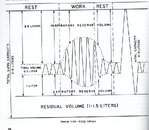But the diaphragm CAN be moved by lungs expanding. This happens when we breath for intubated patients. It would also happen if air was expanding do to decreasing environmental pressure.From a very simplistic standpoint, the lungs inflate because the diaphragm moves....the diaphragm doesn't move because the lungs inflate.
-Z
You are using an out of date browser. It may not display this or other websites correctly.
You should upgrade or use an alternative browser.
You should upgrade or use an alternative browser.
Confused on AGE; holding breath OK if lungs are near-empty?
- Thread starter ScubaSamScubaStevesFather
- Start date
-
- Tags
- age barotrauma
Please register or login
Welcome to ScubaBoard, the world's largest scuba diving community. Registration is not required to read the forums, but we encourage you to join. Joining has its benefits and enables you to participate in the discussions.
Benefits of registering include
- Ability to post and comment on topics and discussions.
- A Free photo gallery to share your dive photos with the world.
- You can make this box go away
There are a few problems with your statement. First, you are never "out of air" because you have a residual volume in your lungs. If you look at the diagram below, you have a expiratory reserve volume of at least one liter of air. Let's say you are ascending from 132 feet. That's five atmospheres of absolute pressure. Your one liter will become five liters as you ascend. You will need to open your glottis, and exhale on the way up as you will have more air than your lungs can hold.Lets see. You have a little air in your lungs, you're holding your breath, you're making a rapid ascent because you are out of air and going to use CESA because you are deep. Pulmonary barotrauma and AGE are the least of your worries.
The second is the CESA, which is a "Controlled Emergency Swimming Ascent." Controlled means you don't make a "rapid ascent" to the surface. You simply swim up to the surface. There is no need to panic in this situation, and it isn't that "Pulmonary barotrauma and AGE are the least of your worries." Actually, pulmonary barotrauma and AGE should be the greatest of your worries, as you have more air in your lungs than is necessary to swim to the surface. This is what a lot of people don't understand about this situation. Jacques Cousteau, in his book The Silent World, stated it succinctly when he talked about some of the first diving courses taught by Frédérick Dumas.
I have made ECSAs from well over 35 feet with no problems.At the end of the course the hono students swim down to a hundred feet, remove all equipment and return to the surface naked. The baccalaureate is an enjoyable rite. As they soar with their original lungful, the air expands progressively in the journey through the lessening pressures, issuing a continuous stream of bubbles from puckered lips.
Cousteau, Jacques and Frédérick Dumas, The Silevt World, Harper & Brothers Publishes, New York 1953, page 180.
SeaRat
Attachments
Dunno. I work with everything but animals. I think the meaning was layers of cells. Cells (with a few weird bacterial exceptions) have just a single membrane around the outside. (Though some internal structures have two.)umm.....cell layers or cell membrane layers?....precision begs the question.
-Z
Bored yet? I could go on....
This maneuver in an emergency would require a great deal of thought. I hope this is just a hypothetical inquiry, not a precursor to a disaster in the making…kinda like using the stale exhaust in your BCD as a possible source of emergency air. Let me be crystal clear…PLEASE DON’T ATTEMPT A N Y of this. A good way to end up in a ‘chamber’, the Hospital or much worse. I have run out of air and followed the instructions from my ( Yes ) Basic SCUBA class. Even though my lungs were essentially empty. As I carefully ascended I was able to get breaths every 15+/-‘ of ascent. Yes, this works. Even when tired cold, and some of the most adverse water and weather conditions exacerbating this event. Other ‘issues’ can come into play making this way too complex to comprehend. I DO care about ALL of my ‘dive-buddies’ familiar and strange. Please leave this to ‘researchers’ using computer models and don’t expariment with this idea.….Why would one even think abut doing this? What is the point?
Sincerely,
Scott G. Bonser, PADI DM since ‘84, Harrellsville, NC
the ‘giantfroginthepool’
Similar threads
- Replies
- 11
- Views
- 1,035
- Replies
- 15
- Views
- 1,576
- Replies
- 1
- Views
- 1,157
- Replies
- 7
- Views
- 1,638




